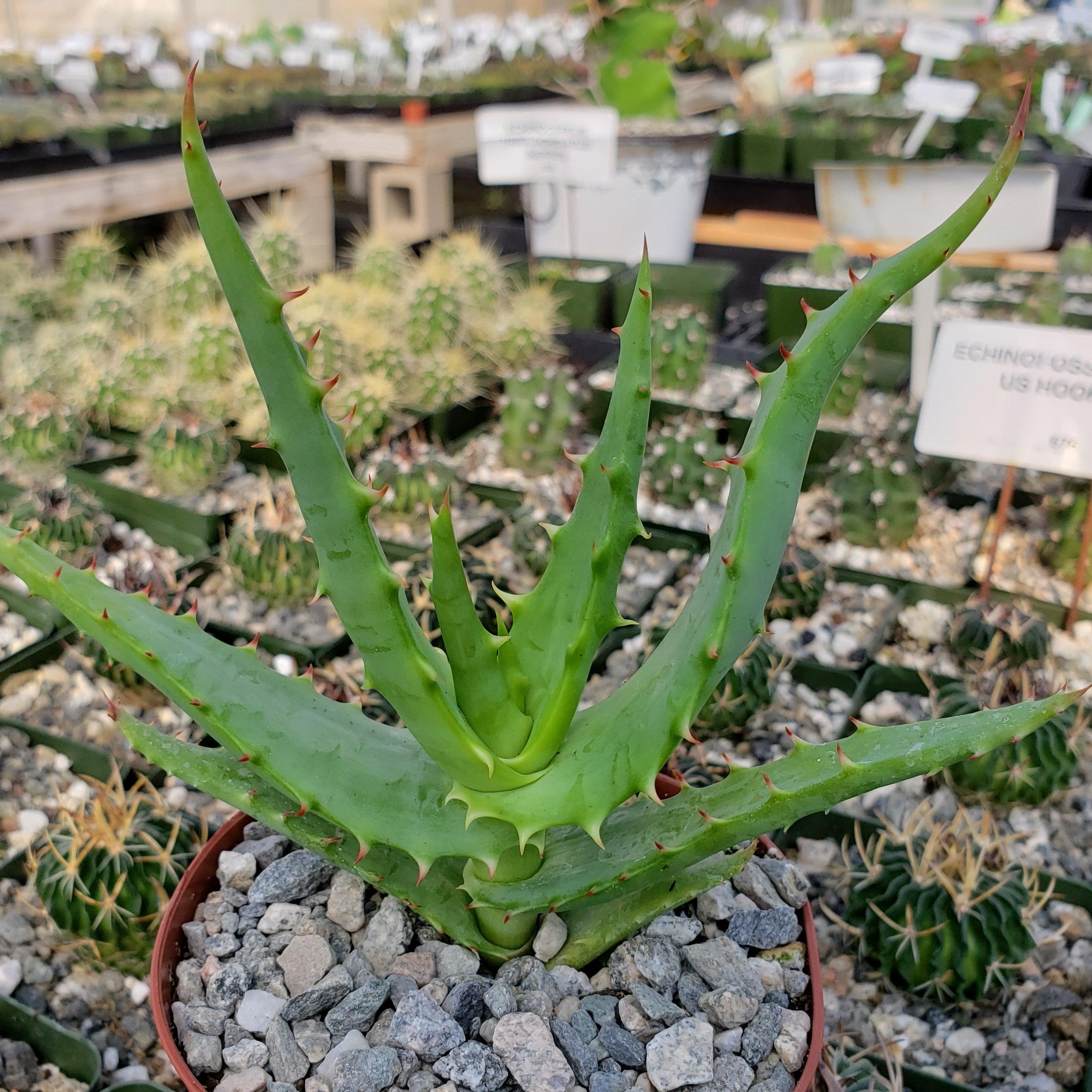Aloe africana is a solitary, often unbranched, small, tree-like Aloe, usually up to 6 feet (1.8 m) but sometimes taller with rosettes densely crowded with gracefully arching 2 foot (60 cm) long lance-shaped thick grayish blue-green leaves that have prominent sharp red teeth along the margins and in a row running along the middle of the lower surface with older leaves skirting the trunk. Flowering on this species can happen at other times but most often in mid-winter to early spring (January-March) with an unbranched to fewbranched up to 3 foot (90 cm) inflorescence of erect long-tapering terminal spikes of flowers that are orange in bud and turn yellow just prior to opening from the bottom of the spike upwards. The individual flowers are held in a downward inclination but uniquely turn upwards towards the tips, making identification of this species quite easy.
Source: worldofsucculents
Some of the information in this description has been found at desert-tropicals.com, llifle.com and cactus-art.biz
Bloom Season
Flower Color
Growth Rate
Hardiness Zone
Mature Size
Resistance
Sun Exposure
| Bloom Season | Blooms all year |
|---|---|
| Botanical Name | Aloe africana |
| Common Name | Uitenhage aloe |
| Dormancy | Winter |
| Family | Asphodelaceae |
| Flower Color | Redorange |
| Genus | Aloe |
| Growth Habit | Rosette |
| Growth Rate | Slow growth |
| Hardiness Zone | 9b to 11 |
| Mature Size | 412 ft. |
| Native Area | South africa |
| Resistance | 4.5ºc |
| Sun Exposure | Full sun (6+ hrs.) |
Growers Quick Reference Guide - Key Features
| Bloom Season | Blooms all year |
|---|---|
| Botanical Name | Aloe africana |
| Common Name | Uitenhage aloe |
| Dormancy | Winter |
| Family | Asphodelaceae |
| Flower Color | Redorange |
| Genus | Aloe |
| Growth Habit | Rosette |
| Growth Rate | Slow growth |
| Hardiness Zone | 9b to 11 |
| Mature Size | 412 ft. |
| Native Area | South africa |
| Resistance | 4.5ºc |
| Sun Exposure | Full sun (6+ hrs.) |
- Description
- Key Plant Features
Aloe africana is a solitary, often unbranched, small, tree-like Aloe, usually up to 6 feet (1.8 m) but sometimes taller with rosettes densely crowded with gracefully arching 2 foot (60 cm) long lance-shaped thick grayish blue-green leaves that have prominent sharp red teeth along the margins and in a row running along the middle of the lower surface with older leaves skirting the trunk. Flowering on this species can happen at other times but most often in mid-winter to early spring (January-March) with an unbranched to fewbranched up to 3 foot (90 cm) inflorescence of erect long-tapering terminal spikes of flowers that are orange in bud and turn yellow just prior to opening from the bottom of the spike upwards. The individual flowers are held in a downward inclination but uniquely turn upwards towards the tips, making identification of this species quite easy.
Source: worldofsucculents
Some of the information in this description has been found at desert-tropicals.com, llifle.com and cactus-art.biz
Bloom Season
Flower Color
Growth Rate
Hardiness Zone
Mature Size
Resistance
Sun Exposure
| Bloom Season | Blooms all year |
|---|---|
| Botanical Name | Aloe africana |
| Common Name | Uitenhage aloe |
| Dormancy | Winter |
| Family | Asphodelaceae |
| Flower Color | Redorange |
| Genus | Aloe |
| Growth Habit | Rosette |
| Growth Rate | Slow growth |
| Hardiness Zone | 9b to 11 |
| Mature Size | 412 ft. |
| Native Area | South africa |
| Resistance | 4.5ºc |
| Sun Exposure | Full sun (6+ hrs.) |
Growers Quick Reference Guide - Key Features
| Bloom Season | Blooms all year |
|---|---|
| Botanical Name | Aloe africana |
| Common Name | Uitenhage aloe |
| Dormancy | Winter |
| Family | Asphodelaceae |
| Flower Color | Redorange |
| Genus | Aloe |
| Growth Habit | Rosette |
| Growth Rate | Slow growth |
| Hardiness Zone | 9b to 11 |
| Mature Size | 412 ft. |
| Native Area | South africa |
| Resistance | 4.5ºc |
| Sun Exposure | Full sun (6+ hrs.) |
























